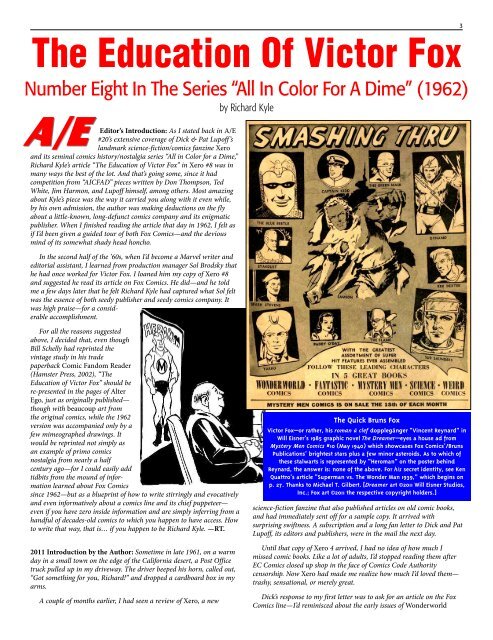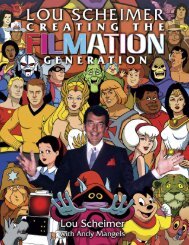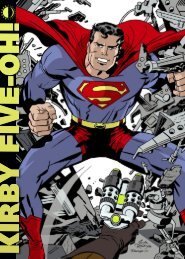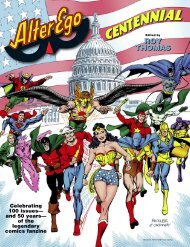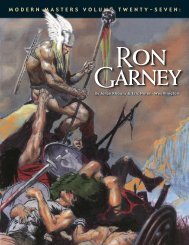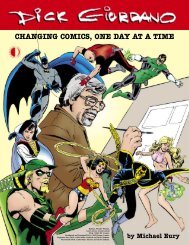The Education Of Victor Fox - TwoMorrows
The Education Of Victor Fox - TwoMorrows
The Education Of Victor Fox - TwoMorrows
Create successful ePaper yourself
Turn your PDF publications into a flip-book with our unique Google optimized e-Paper software.
3<br />
<strong>The</strong> <strong>Education</strong> <strong>Of</strong> <strong>Victor</strong> <strong>Fox</strong><br />
Number Eight In <strong>The</strong> Series “All In Color For A Dime” (1962)<br />
by Richard Kyle<br />
A / E<br />
Editor’s Introduction: As I stated back in A/E<br />
#20’s extensive coverage of Dick & Pat Lupoff ’s<br />
landmark science-fiction/comics fanzine Xero<br />
and its seminal comics history/nostalgia series “All in Color for a Dime,”<br />
Richard Kyle’s article “<strong>The</strong> <strong>Education</strong> of <strong>Victor</strong> <strong>Fox</strong>” in Xero #8 was in<br />
many ways the best of the lot. And that’s going some, since it had<br />
competition from “AICFAD” pieces written by Don Thompson, Ted<br />
White, Jim Harmon, and Lupoff himself, among others. Most amazing<br />
about Kyle’s piece was the way it carried you along with it even while,<br />
by his own admission, the author was making deductions on the fly<br />
about a little-known, long-defunct comics company and its enigmatic<br />
publisher. When I finished reading the article that day in 1962, I felt as<br />
if I’d been given a guided tour of both <strong>Fox</strong> Comics—and the devious<br />
mind of its somewhat shady head honcho.<br />
In the second half of the ’60s, when I’d become a Marvel writer and<br />
editorial assistant, I learned from production manager Sol Brodsky that<br />
he had once worked for <strong>Victor</strong> <strong>Fox</strong>. I loaned him my copy of Xero #8<br />
and suggested he read its article on <strong>Fox</strong> Comics. He did—and he told<br />
me a few days later that he felt Richard Kyle had captured what Sol felt<br />
was the essence of both seedy publisher and seedy comics company. It<br />
was high praise—for a considerable<br />
accomplishment.<br />
For all the reasons suggested<br />
above, I decided that, even though<br />
Bill Schelly had reprinted the<br />
vintage study in his trade<br />
paperback Comic Fandom Reader<br />
(Hamster Press, 2002), “<strong>The</strong><br />
<strong>Education</strong> of <strong>Victor</strong> <strong>Fox</strong>” should be<br />
re-presented in the pages of Alter<br />
Ego, just as originally published—<br />
though with beaucoup art from<br />
the original comics, while the 1962<br />
version was accompanied only by a<br />
few mimeographed drawings. It<br />
would be reprinted not simply as<br />
an example of primo comics<br />
nostalgia from nearly a half<br />
century ago—for I could easily add<br />
tidbits from the mound of information<br />
learned about <strong>Fox</strong> Comics<br />
since 1962—but as a blueprint of how to write stirringly and evocatively<br />
and even informatively about a comics line and its chief puppeteer—<br />
even if you have zero inside information and are simply inferring from a<br />
handful of decades-old comics to which you happen to have access. How<br />
to write that way, that is… if you happen to be Richard Kyle. —RT.<br />
2011 Introduction by the Author: Sometime in late 1961, on a warm<br />
day in a small town on the edge of the California desert, a Post <strong>Of</strong>fice<br />
truck pulled up in my driveway. <strong>The</strong> driver beeped his horn, called out,<br />
“Got something for you, Richard!” and dropped a cardboard box in my<br />
arms.<br />
A couple of months earlier, I had seen a review of Xero, a new<br />
<strong>The</strong> Quick Bruns <strong>Fox</strong><br />
<strong>Victor</strong> <strong>Fox</strong>—or rather, his roman à clef dopplegänger “Vincent Reynard” in<br />
Will Eisner’s 1985 graphic novel <strong>The</strong> Dreamer—eyes a house ad from<br />
Mystery Men Comics #10 (May 1940) which showcases <strong>Fox</strong> Comics’/Bruns<br />
Publications’ brightest stars plus a few minor asteroids. As to which of<br />
these stalwarts is represented by “Heroman” on the poster behind<br />
Reynard, the answer is: none of the above. For his secret identity, see Ken<br />
Quattro’s article “Superman vs. <strong>The</strong> Wonder Man 1939,” which begins on<br />
p. 27. Thanks to Michael T. Gilbert. [Dreamer art ©2011 Will Eisner Studios,<br />
Inc.; <strong>Fox</strong> art ©2011 the respective copyright holders.]<br />
science-fiction fanzine that also published articles on old comic books,<br />
and had immediately sent off for a sample copy. It arrived with<br />
surprising swiftness. A subscription and a long fan letter to Dick and Pat<br />
Lupoff, its editors and publishers, were in the mail the next day.<br />
Until that copy of Xero 4 arrived, I had no idea of how much I<br />
missed comic books. Like a lot of adults, I’d stopped reading them after<br />
EC Comics closed up shop in the face of Comics Code Authority<br />
censorship. Now Xero had made me realize how much I’d loved them—<br />
trashy, sensational, or merely great.<br />
Dick’s response to my first letter was to ask for an article on the <strong>Fox</strong><br />
Comics line—I’d reminisced about the early issues of Wonderworld


